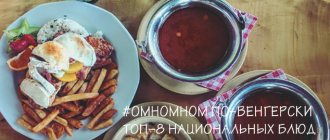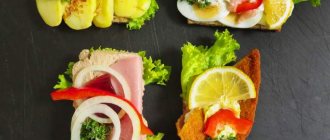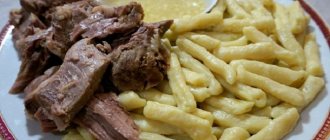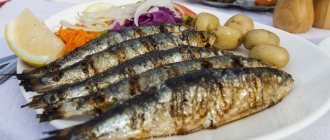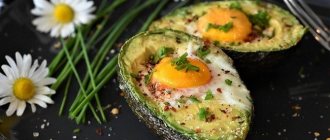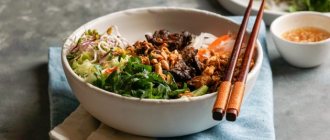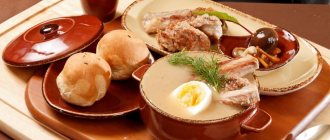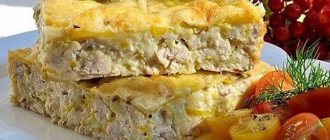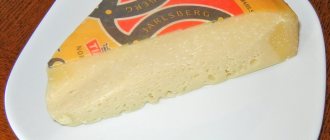It is often said about Austria that it is a small country with great cuisine. And indeed it is. Over the centuries, Austrian cuisine has diligently accumulated the best dishes from different countries, carefully adapting them according to its own principles and cooking technology. As a result, absolutely unique culinary traditions have been formed, allowing one to experiment with familiar tastes and make changes to traditional recipes.
Wiener Schnitzel
German Wiener Schnitzel
Schnitzel needs no introduction - this dish has become a household name in many countries. It can be found on the menu of restaurants and snack bars as often as pizza, pasta or hamburger. All the more compelling is the reason to order schnitzel in Austria in order to understand how it is prepared at home and how real Viennese differs from numerous copies. Schnitzel is essentially a classic chop. A thinly pounded piece of meat with flour, beaten egg and breadcrumbs, fried in a large amount of hot oil. The peculiarity of Wiener schnitzel is that it is never prepared from pork (only juicy veal) and is never fried in vegetable oil (only butter or melted pork fat).
Whether this is the secret of cooking or there are other wisdom, the Austrian chefs are silent. But the best schnitzel can only be tasted in Vienna.
general characteristics
Austrians developed a reverent attitude towards food many centuries ago. Residents of the Austro-Hungarian Empire have always been famous for their love of noisy feasts - and this statement is true for all segments of the population, from peasants to nobility. Each family had its own recipes for original dishes that were passed down from generation to generation.
At the same time, the Austro-Hungarian Empire, whose population in 1914 was fifty-two million people, is often called “patchwork” - because representatives of a huge number of nationalities lived on its territory. Germans, Hungarians, Czechs, Slovaks, Poles, Rusyns, Romanians, Italians, Jews, Croats and even gypsies - they all contributed to the formation of the unique Austrian cuisine.
Content:
- general characteristics
- Characteristics
- Main dishes and drinks
- Useful properties and contraindications
- Preparing the Sacher Torte
- Cooking buckhandle (Viennese chicken)
Moreover, if in most world monarchies it was the royal court and aristocrats who were considered “trend setters” and “set the tone” for the main culinary trends, in Austria-Hungary everything happened exactly the opposite. The Viennese elite in the imperial palace enjoyed dishes that were “born” in peasant kitchens.
This is one of the main distinguishing characteristics of traditional Austrian cuisine - among its dishes that have won worldwide recognition, there are no overly expensive ones, it is very “democratic”. Roast beef, fried tenderloin, and Vienna rump were served on the festive table both in the family of a simple worker and in aristocratic houses.
Today, experts often argue about whether the concepts of “Austrian cuisine” and “Viennese cuisine” can be completely identified. The thing is that Austrian cuisine includes a huge number of regional variations of the same dishes. In turn, Viennese cuisine is famous primarily for its baked goods (cakes, strudels) and combines the main culinary masterpieces of Vienna.
Tafelspitz
German Tafelspitz
Many people fall in love with another legendary Viennese meat dish. Tafelspitz is boiled beef rump with vegetables and broth. In restaurants it is served with grated horseradish, fresh bread and applesauce. True, sometimes mashed potatoes are replaced with potatoes. This is also delicious, but if you want to try the classic combination, choose a place that serves it with apple. After 5 hours of cooking, the meat literally melts in your mouth - and this is the main secret of Tafelspitz. In addition, portioned pieces of beef have a pointed shape after cooking. Green beans in a creamy sauce with herbs are ideal as a side dish.
Soups
Stosuppe
This dish is similar to okroshka cooked with kefir. Basic ingredients - potatoes, bay leaf, parsley, cumin. Everything is filled with sour cream or sour cream. This is why stosuppe is called milk soup.
Apfelsuppe
This apple soup has a creamy texture. In addition to fresh apples, spices, starch, eggs, cream, onions, lemon and beef broth are used. The boiled ingredients are crushed with a blender, which is why the soup has the most delicate texture. You can use a few apple slices to garnish the dish.
Apple strudel
German Apfelstrudel
Apple strudel is the simplest traditional dessert. In its classic form it is apple. But it can be sausage, potato, milk-cream, sugar, cabbage. In newfangled Viennese establishments it is made with cherry or apricot filling and served with a scoop of ice cream or cream. But still, in places like Demel or Cafe Central, the strudel can only be apple. If you are lucky enough to be in Austria, be sure to try the national dish, which has become famous throughout the world. You will not regret!
During the 2-hour “Leisurely Walk through Schönbrunn Park” you can not only hear the history of the imperial residence, but also attend a strudel show. In front of visitors to Schönbrunn Palace, pastry chefs reveal the secrets of the Austrians' favorite dessert.
Austrian strudel is one of those dishes that is easy to replicate in your own kitchen. If you don’t want to prepare the dough, you can use ready-made dough.
- Recipe
- Photo
- For this you will need: flour - 2.75 cups; butter / margarine - 4 tbsp. spoons; chicken egg - 1 pc.; acetic acid (70%) - ½ tbsp. l.; salt - ½ tsp; medium-sized apples - 4 pcs.; raisins - 100 g; powdered sugar - 1 tbsp. l.; sugar - 4 tbsp. l.; peeled walnuts - 50 g; cinnamon - 1 tsp.
- It is recommended to prepare the dough several hours before baking. You need to mix flour, half the butter and salt. Then you need to stir the egg in a glass of water and pour the resulting mixture into the dough. And also add vinegar.
The ingredients for the strudel should be mixed well and the dough should be rolled out. Then cover with cling film and refrigerate for several hours.
- For the filling, cut the apples into slices and cubes, chop the nuts well. Melt the remaining butter in a frying pan and lightly fry the apples, raisins, and nuts. At the end of simmering you need to add cinnamon and sugar.
- It's time to prepare the strudel itself. Preheat the oven to 200 degrees. Remove the dough from the refrigerator and divide it into two parts. Roll out each half quite thinly. The main thing is to act carefully so as not to tear the dough. Then put the filling on the edge and roll it up (see photo in the tab).
- Place the strudels on the prepared greased baking sheet. Glue the edges of the dough. It is advisable to grease the top of each strudel with vegetable oil. Apfelstrudel should be baked for half an hour.
- Once cooked, let them cool slightly, then sprinkle with powdered sugar. An excellent Austrian dish is ready!
- Carefully place the filling onto the rolled out dough:
And also carefully close everything in an “envelope”:
Features of preparing Easter pie
As we have already said, almost all national dishes of Austria are prepared very simply and quickly. Christmas cake is no exception. First, let's prepare the dough. Take a small container in which yeast, granulated sugar and warm water are mixed. While the yeast is “rising”, sift the flour and mix it with warm milk and water. Place in a warm place for 25 minutes. After the specified period of time, mix all the ingredients for the dough. Form a lump, cover it with a towel and put it aside for 15 minutes.
Pour boiling water over dried fruits (raisins, dried apricots, etc.). Then dry and mix with sugar and butter. If nuts are used, they should be chopped. The dough is rolled out in a special way. One edge must be slightly longer and thicker than the other. This is done so that when rolling into a roll, the dough does not tear or make holes under the weight of the filling.
Brush the dough with melted butter using a brush. Pour all the prepared filling on top. We wrap it in a roll. Now we place it in a special round baking dish. Cook for 25 minutes at 190 degrees.
Schweinebraten
German Schweinebraten
Schweinebraten came to Austria from neighboring Bavaria, and stayed that way. Traditionally, aromatic roast pork shoulder should be simmered in the oven for a long time and served with potato salad (be careful, it is prepared with wine vinegar), stewed cabbage (often first sauerkraut and only then stewed) and a glass of beer. Schweinebraten rarely appears on the menu of elite Viennese restaurants, but in traditional taverns it is the No. 1 dish. Tourists most often try it in the mountains, after an active day at one of the ski resorts in Austria. Or at the German Oktoberfest.
Famous national dishes of Austria
The most famous dish of Austrian cuisine is Wiener Schnitzel . It’s worth going to a restaurant for this alone: a juicy plate-sized veal chop in golden breading can really surprise you.
The taste of this schnitzel is also excellent. It is usually served with potato or cabbage salad, and after such a hearty meal you are unlikely to need to order anything else. Don't worry about not being able to finish the schnitzel.
The meat for it is beaten very thin, and any tourist who has worked up an appetite during excursions in Vienna .
Vienna sausages are usually listed on menus under the name Frankfurter . There is an opinion that their recipe was invented by the Frankfurt butcher Johann Laner, adding beef to the traditional minced pork. Please note that sausages in Austria are not boiled, but fried, which is why they turn out unusually fatty.
- Food at ski resorts in Austria
The hallmark of Viennese cuisine, strudel , at first glance may seem like a simple dish. A juicy filling of sliced apples with sugar, wrapped in the finest dough - this is a real Viennese Apfelstrudel.
There is another option, with curd filling, it is called Topfenstrudel . And in general, anything can be used as a filling: apricots, cherries, poppy seeds, even spinach.
It is recommended not only to try the strudel, but first to watch how it is prepared. Entire shows are organized based on the preparation of this delicacy, and master classes are held for those interested.
- Strudel show in Schönbrunn
The second most famous Austrian dessert is Sachertorte . Chocolate sponge cakes, smeared with apricot jam and filled with chocolate glaze, have a refined and unique taste.
The recipe for this cake was once the subject of litigation. Their result was the approval of two versions of the recipe: one of them is used in the Sacher confectionery, the other in the Demel confectionery .
But when it comes to Viennese coffee, confusion arises. Some people mean chilled coffee with ice cream, others mean half-and-half coffee with foamed milk, known as “mélange.” Either way, both options are popular in Austria: try them both and decide which you like best.
Tasting these dishes has long been part of the excursion program. But sometimes tourists just need to eat. What else should you try from traditional Austrian dishes?
Salads
The most popular salad in Vienna is called: “Viennese salad” - Wiener Salat . Its composition is very simple: potatoes, cabbage and garlic. Therefore, sometimes it appears on the menu under the name Erdapfel Salat , that is, potato salad.
There are other options when, instead of cabbage, pickled onions are added to the salad or pickles are added. The dressing is vegetable oil, vinegar, and sometimes horseradish or mustard.
Carinthia has its own special salad, which is made from lettuce and chicory. You can usually find other salads on restaurant menus - from boiled and fresh vegetables, with the addition of meat.
Soups
Soups in Austria are traditionally cooked with meat broth. Beef broth with various dressings turns into delicious dishes.
- Frittatensuppe - broth with pancakes cut into thin strips.
- Backerbsensuppe – with deep-fried dough balls.
- Leberknödelsuppe – soup with liver meatballs.
- Gemüsesuppe is a light vegetable soup.
In Austria they also prepare goulash - a fatty, rich soup made from meat and vegetables. Austrian goulash is not as thick as Hungarian goulash, and not as spicy.
If you want to surprise a young gourmet, offer him Apfelsuppe - apple soup.
But the milk soup, Stosuppe , is a bit like okroshka with kefir. It consists of potatoes seasoned with caraway seeds and doused with sour milk or sour cream.
Main dishes
There is plenty to choose from among meat dishes. First of all, this is Tafelspitz , which is simmered over low heat for about 5 hours in a broth with roots.
Potatoes, either boiled or fried in lard, often serve as a side dish for the most tender meat. As an unusual and at the same time light side dish, you can order stewed Jerusalem artichoke - Erdäpfelgulasch .
You should also try fried chicken Backhuhn or fried chicken Backhendl , roast beef with onions Zwiebelrostbraten , and also order one of the many cutlets, meatballs, and entrecotes. And for children who are difficult to seat at the table because they like to snack and run away, you can offer a baguette with Vienna sausage.
While vacationing in Carinthia, you can try dishes from trout (Forelle), pike perch (Fogosch), pike (Hecht), carp (Karpfen) and other river fish.
Vegetable and pasta dishes
Pasta lovers will find dishes to their liking. For example, Kasnudeln resembles ravioli with cheese filling, Schlipkrapfen - with meat filling. Schupfnudel – noodles made from potato flour – is very tasty
A hearty dish is Schinkenfleckerl , a pasta casserole with ham.
Groestl is often found on the menu of Tyrolean taverns . This is a fatty dish of potatoes fried in oil or lard along with meat and tomatoes. Grestl is seasoned with aromatic herbs and served with fried eggs.
Dessert
But in terms of what Austria can give a head start to many countries, it is in terms of sweets and desserts. This is where the virtuosity comes into play: the best patisseries in Vienna make real works of art, complex, intricately decorated. What desserts are typical for Austrian cuisine? What should you try from the dozens of types of cakes, pastries and cookies?
Unlike Hungarian desserts, which use a lot of buttercream, Austrian sweets are a bit dry. A clear confirmation of this is the Sachertorte, which combines sponge cake, apricot confiture and chocolate glaze. Another example is the Linzer Torte, made from almond shortcrust pastry with berry filling.
But the omelette here turns into a feast for the stomach. The Kaiserschmarrn omelette is made sweet by adding flour, raisins and cinnamon to eggs beaten with milk. A crispy, golden-brown pancake served with powdered sugar or caramel syrup.
the Buchteln floating in glass cases - boat-shaped pies with poppy or nut filling, puff pastries with all kinds of fillings, sponge cakes, Kipferl , and Palatschinken - sweet pancakes with ice cream and chocolate syrup.
And if you are in Austria for Christmas, be sure to try Stollen, made from rich yeast dough with candied fruits.
An exquisite, melt-in-your-mouth dessert - Nockerln . Soufflé made from eggs and cream is baked until golden brown and served with lingonberry sauce. Salzburg is considered the birthplace of this dessert, but you can try nockerln in any confectionery shop in Austria.
- Viennese sweets: review
Beverages
Traditionally, desserts in Austria are served with coffee, and if you are ready to introduce your children to this drink, order milk coffee from the Milchkaffee . Almdudler herbal lemonade , which is fizzy, aromatic and refreshing.
And at ski resorts you can sometimes find a non-alcoholic version of the warming drink Jagatee, made from freshly brewed tea and heated fruit juice with spices. But it’s also not difficult to find tea and cocoa on the menu.
Käzespätzle
German Keseshpetsle
Käsespätzle, like Schweinebraten, has taken root in both Austria and Germany. These are delicious homemade noodles cooked with cheese. A simple traditional dish that can be found in every Austrian home where it is customary to have family dinners. Käzespätzle has rural origins, so the recipe is extremely simple. The dough requires flour, eggs, vegetable oil, salt/pepper and some water. To enhance the taste, sprinkle the finished noodles with grated raw and thinly sliced onion, lightly browned in a frying pan. If it's in season, serve with lots of greens.
Austrian chicken
Another recipe that you can’t help but share is Viennese chicken. It is prepared very quickly, the ingredients are accessible and understandable, and even novice housewives can do the process.
Products for the dish:
- chicken drumsticks;
- spoon of lemon juice;
- 3 spoons of breadcrumbs;
- the same amount of flour;
- salt;
- oil;
- ground pepper;
- egg.
Mix bread crumbs with salt, flour and ground pepper. Marinate the chicken drumsticks in lemon juice for ten minutes. Dip the meat in the egg and breading mixture. Fry in a small amount of oil (you can also use olive oil). As soon as the crust appears golden brown, the chicken is ready. It would seem that there is no secret, but lemon breading adds a lot to this dish. It was the Austrians who first came up with the idea of using lemon juice to marinate chicken before frying.
Salzburg Nockerln
German Salzburger Nockerln
Salzburg “nockerln” (the phrase is translated into Russian as Salzburg “dumplings”) is one of the most unusual desserts that are available for tasting in Austria. An airy sweet made from eggs, flour and sugar, beaten into a soufflé and baked in the oven. You don't have to be in Salzburg to try it. You can also find a restaurant in Vienna where nockerln is on the menu. The author of the recipe is considered to be Salome Alt, the daughter of a wealthy merchant from Salzburg and the mistress of Prince Wolf Dietrich Raitenau. It was invented back in the 17th century. According to legend, the shape of the dessert - hills of soufflé - symbolizes the mountains surrounding the city. We are talking about the peaks Festungsberg, Mönchsberg, Kapuzinerberg (wikipedia.org).
Along with apple strudel and kaiserschmarrn (crispy cinnamon omelette), fluffy Salzburg nockerln has become the pride of Austrian cuisine.
Characteristics
As noted above, Austrian cuisine has united the culinary trends of a huge number of nationalities and is one of the most diverse and original in the world. However, it also has its own characteristic features.
- Austrian cuisine is conservative. Of course, over time, ancient recipes are modified, some ingredients are replaced by others, but in Austria they seriously believe that the best delicacy must stand the test of time. In other words, ancient cookbooks are held in high esteem here.
- There are very few truly spicy dishes here. Seasonings are not overused in Austria.
- Austrian cuisine is one of the most regionally structured in the world. Today, Austria is divided into several regions, each of which boasts its own culinary traditions. For example, Viennese cuisine has gained worldwide fame for its baked goods; in Lower Austria, the menu contains a large number of game dishes; in Burgenland the diet was influenced by Hungarian cuisine; in Styria they practically do not use other types of oil except pumpkin oil; in Carinthia, the basis of the diet of local residents is seafood; The cuisine of Upper Austria is based on the traditions of Bavaria and Bohemia. Cheese lovers flock to Salzburg, and legendary dumplings and ravioli are prepared in Tyrol.
- Austrian delicacies are not for those who want to lose weight. All of them are very high in calories. Moreover, the portions here are usually not just large, but very large. In Austria they love to eat well and satisfyingly, and being overweight here is not at all a reason for complexes.
Kaiserschmarrn
German Kaiserschmarren
The dish with the melodious name “Kaiserschmarrn” is nothing more than a crispy omelet with sugar, milk, cinnamon, raisins and eggs. High in calories, but tasty. You can easily afford it for breakfast. Especially in winter and especially if you are in Vienna and have a day ahead full of excursions and walks (especially since Kaiserschmarrn is a dish of Viennese cuisine). And if you ski in the mountains, there is no question that kaiserschmarren will only benefit you! By the way, historians are still arguing over the origin of the name of the dessert. At first glance, the word kaiser hints at an imperial meaning, that is, a dish created especially for the Kaiser. But in Austrian it also means “best” - dessert of the highest quality!
Be that as it may, Emperor Franz Joseph I adored Kaiserschmarrn for its taste. And ordinary Austrians valued it for its simplicity, availability and satiety.
Waffles from )
This is one of the symbols of “sweet Austria”. Five wafer bars with sweet cream as a layer between them.
Manner was founded in 1890. Waffles became one of the first products and are still the “calling card” of this confectionery house. The delicacy has been produced since 1898. Joseph Menner himself called them “Neapolitan”, since the original recipe contained hazelnuts growing in the vicinity of this Italian town.
Waffles from the Menner company
Now the number of fillings has increased significantly. The most popular: chocolate, lemon, nut, they are often packaged in assorted sets. Confectioners are also experimenting with honey, jams, cereals, sweet creams, berries, coconut and even cheese and bacon.
Waffles from the Menner company with nut filling
The wrapper of the legendary delicacy has already become a brand - pink, with the silhouette of St. Stephen's Cathedral (in the 1890s, when Joseph Manner opened his first store, it was located next to this cathedral. The Archdiocese of Vienna and the company entered into an agreement to use a photograph of the cathedral - in exchange for payment of wages to one mason who performed repair work on this architectural site).
Waffles from )
True, waffles were initially sold by weight, and only since the 20s of the last century - in packs of 10 pieces measuring 47x17x17 mm. .
Austriadessertvacationphoto report
Sachertorte
German Sachertorte
In 2022, the Sacher Empire will celebrate 190 years since the invention of the Viennese cake. Aspiring pastry chef Franz Sacher, who was interning in the court confectionery, accidentally developed the recipe for the future masterpiece. Why future? Yes, because at that time the chocolate biscuits, combined with apricot jam and topped with glaze, did not make an impression on the Austrian court - it was there that the first copy of Sacher was sent. But the 16-year-old boy did not stop: he improved the recipe, experimented with ingredients. Until he bequeathed to the children to “work tirelessly on the cake.” So, Eduard Zacher, who inherited the recipe, brought the cake to perfection.
Unlike his father, he studied confectionery not at court, but in the Demel cafe. There the delicacy was appreciated and put on stream. Sacher was sold at Demel until Eduard saved up the money to open a hotel. Since then, a sponge cake with apricot jam and a thick layer of glaze made from a mixture of three types of chocolate has been sold in the Sacher cafe chain.
The classic cake recipe is the property of the family and is kept secret. Even though Sacher is baked all over the world, the classic ingredients are just guesses from experienced pastry chefs.
The Austrian delicacy has become so popular that you can try it for a long time not only in Vienna, but far beyond the borders of the capital and even the country. If you have basic culinary skills, you can easily bake Sacher at home. And if you also add a bit of ingenuity, you can easily do without scarce products - like apricot jam or three types of expensive chocolate. But despite all the tricks, there is a standard recipe for Sacher torte, which no one has yet managed to surpass. You can try it only in Austria.
And it doesn’t matter where - in Vienna, Salzburg, Innsbruck, Graz - the main thing is in the homeland. After all, even the standard ingredients of the cake are still kept secret. And everything else is just bold variations on the theme of a brilliant recipe.
Addresses of Sacher branded cafes in Austria:
- Café Sacher Wien is located on the ground floor of the Hotel Sacher. Address: Philharmoniker Str. 4, 1010 Vienna. The opening hours of the capital's cafe are most convenient for travelers: from 8:00 to 00:00, without breaks and weekends.
- Café Sacher Salzburg is also located in the Sacher Hotel. Address: Schwarzstraße 5-7, 5020 Salzburg. Opening hours: from 7:30 to 23:00, without breaks and weekends.
- Café Sacher Innsbruck does not operate at the hotel. The cafe building is located in the heart of the Old Town, not far from the House with the Golden Roof. Address: Rennweg 1, 6020 Innsbruck. Opening hours on visited days from Thursday to Saturday: from 8:30 to 00:00. From Sunday to Wednesday: from 8:30 and only until 22:00.
- Café Sacher Graz is also an independent establishment. Address: Herrengasse 6, 8010 Graz. Opening hours: from 8:30 to 21:00, seven days a week. Exception Sunday: Café Sacher opens on this day at 11:00 and is open until 18:00.
An online store has been operating on the official website www.sacher.com for several years. There, anyone can order a classic Sachertorte (chocolate-covered, with the company logo) and have it delivered to your home. The cost of such pleasure is from 29.00 € for a tiny diameter “Piccolo” to 55.50 € for a full 3rd size.
Candies Mozartkugel (German: Mozartkugeln)
Traditional round chocolates filled with marzipan, invented 100 years after the death of Wolfgang Amadeus Mozart by Salzburg confectioner Paul Fürst in 1890. Traditionally they have a round shape, and the name is translated as “Mozart’s balls”.
Candies Mozartkugel (German: Mozartkugel)
In 1905, he presented his dessert at an exhibition in Paris and received a gold medal. In Salzburg there is a monument to the pastry chef - a figurine of a man on a huge golden ball.
human figure on a golden ball
Real Mozartkugel is made by hand. Green pistachio marzipan is formed into a ball and carefully covered with nut nougat. Then the blanks are placed on wooden sticks and dipped in dark chocolate, after which the candies are removed and the hole is covered with chocolate. Original copies have a silver wrapper with a blue portrait of the composer.
Cross-section of Mozartkugel sweets from Manner
The sweetness gained enormous popularity, but Furst did not patent it. These two factors have led to a huge number of counterfeits. Then there were courts, but the author managed to obtain the rights only to the name. And the recipe and technology can be freely used by other manufacturers. Which is what they do. Manual production does not allow making candies in large quantities, but they can be stored for about two months. The original hand-made Mozartkugel is made only in Salzburg in a factory named after Fürst. 1,400,000 pieces are produced per year. They are sold in four company stores, which, again, are located in Salzburg.
Similar candies from other companies are produced both manually and industrially. But even with the help of machines, one such candy takes two and a half hours to make, during which time 14 manipulations occur with it. The largest manufacturer of Mozartkugel in Austria is the Mirabell company. And in the world, the German company Reber produces the most Mozart balls. In both cases, the wrapper is gold foil with a color portrait of the composer. Third-party manufacturers, as a rule, do not preserve the original spherical shape of sweets.
Mozartkugel from Mirabelle
In Austria, thanks to Mozartkugel, culinary know-how appeared: the candies began to be used as a filling for other desserts. For example, it is known that Mozart’s favorite dish was dumplings. Usually their sweet version is made with fruit (apricots or plums). And Mozartknell has the famous candy filling.
The candies are certainly delicious and will especially appeal to lovers of marzipan and chocolate. These candies can make an excellent edible souvenir.
South Tyrolean Schlutzkrapfen
German Schlutzkrapfen
Someone, seeing Schlutzkrapfen, will compare them with Italian ravioli, while others will even call them dumplings (and this will probably be closest to the truth). True Schlutzkrapfen, which is adored in the Tyrolean part of Austria, should be shaped like dumplings. True, this is where the similarity with the masterpiece of Ukrainian cuisine ends. The dough for Schlutzkrapfen is made unusual - from a mixture of wheat and rye flour. Bacon and sauerkraut are traditionally used as filling. But since Austria shares the territory of South Tyrol with Italy, the influence of Italian cuisine could not be avoided. Therefore, ricotta is also added to modern Schlutzkrapfen.
https://www.instagram.com/p/BdibLo0BmgE/
Schlipfkrapfen
If you are on holiday in Tyrol, be sure to try the Schlipfkrapfen. Who would have thought that such an almost unpronounceable name would hide the familiar dumplings! There are almost no differences: sclipfkrapfen (or schlutskrapfen) are made from a mixture of rye and wheat flour, and the filling in them can be very diverse, from potatoes to sauerkraut. Before serving, pour melted hot butter over the dish and sprinkle with grated cheese.
To try Schlipfkrapfen, you will need to pay about €10.
Tyrolean dumplings
German Tiroler Knoedel
Dumplings, similar to large meatballs, are a favorite dish in Tyrol. If you want to try them in Innsbruck, look for the menu called speckknödel, which translates to “spice dumpling”. Good restaurants will tell you that the meat used to make dumplings is selected exclusively from natural farms. And they can be trusted, since using local agricultural products to the maximum is the course chosen at the state level. Otherwise, dumplings are the same cutlets (meat, onions, white bread, herbs), only round in shape.
Meat dishes
Good Viennese restaurants serve many classic meat dishes. The undisputed king of any dinner is the Viennese schnitzel made from young veal, fried in breadcrumbs. It is customary to serve it in such a way that the piece of meat slightly extends beyond the edges of the plate.
Another interesting recipe for Tafelspitz is made from boiled beef, always seasoned with apple horseradish. Also, visiting gourmets are usually partial to Austrian-made goose liver, dried ham and fried bak hun chicken.
Appetizing pieces of tafelspitz with pepper, parsley and apple horseradish
Tyrolean grestl
German Gröstl
Gröstl is another meat dish you can try in Austria. Its homeland, as in the case of Tyrolean dumplings, is Innsbruck. We warn you right away that this dish is not for those on a diet. As your fitness trainer would say, rowing is an ardent opponent of a healthy lifestyle. Judge for yourself: it is prepared from potatoes and beef fried in butter, with the addition of smoked pork breast, tomatoes, herbs and spices. Yes, it's high in calories. But residents of the Alpine regions eat such roasts regularly, look great and live long. And what is the secret, go figure.
Useful properties and contraindications
Nutritionists emphasize that tourists with Austrian cuisine should still be careful. First of all, as already noted, most dishes are very high in calories. Consequently, they can hardly be recommended to adherents of a healthy lifestyle.
In addition, due to the high fat content, many local dishes are not suitable for people suffering from diseases of the digestive system.
At the same time, due to its high protein content, Austrian cuisine can be recommended to people during periods of physical activity, and the abundance of vegetables and fruits helps improve the functioning of the gastrointestinal tract and provides the body with all the necessary vitamins and minerals.
Gugelhupf
German Gugelhupf
Gugelhupf is a must-try holiday cake at the Vienna Christmas market. They are everywhere there: and there are two types - regular and marble, with cocoa added to the dough. Gugelhupf is a real “rum baba”, the closest relative of Italian panettone, Greek vasilopita and French brioche. And, as happens with Austrian dishes and desserts, it is also popular in Germany and France (in particular in Alsace). Initially, the dish is rustic: the composition of the products is traditionally simple and satisfying. But popularity gradually gained momentum, until in the 18th century. Gugelhupf, which had to be soaked all night in rum, did not turn into a fashionable and status dessert.
It is advisable to try the geographically correct “rum baba” in Styria. But in Vienna, Salzburg, and Innsbruck you will find no less delicious Gugelhupf - with raisins, chocolate, lemon, poppy seeds, almonds. Choose according to your taste!
Cake "Cardinal" (Kardinalschnitte)
Cardinal cake is not the most famous of Austrian sweets, but once you try it, it is impossible to forget. Delicate and airy, it will definitely appeal to lovers of exquisite and unusual desserts.
Kardinalscnitte was first prepared in the Viennese patisserie L. Heiner in 1933 on the occasion of a major Catholic holiday. In cross-section, the finished dessert had the colors of the Vatican flag. The strips of biscuit dough turned yellow during baking (the shade was enhanced by the use of apricot jam), and the meringue layer turned white. This is how the classic cake is still prepared in Austria today.
In the Viennese confectionery Aida, those with a sweet tooth can choose from 3 versions of “Cardinal”: with coffee, vanilla and raspberry flavors. The price of dessert is 3.60 €.
Linz cake
German Linzer Torte
Not widely known, but very tasty Austrian cake, worthy of competing with Sacher, Kaiserschmarrn and Apple Strudel. It's not even a cake, it's a pie with fruit and berry jam. In addition to flour, the dough of Linz cake (or tart) contains almond oil. It gives a recognizable taste. And the most important detail is the thin lattice of dough decorating the top of the pie. Today it will surprise few people, but the Austrian entrepreneur of the 19th century. Johann Conrad Vogel, who put cake production on stream, was an innovator with this type of decoration.
Punchkrapfen
These small Austrian cakes usually attract the eye with their unusually bright colors. The dessert is prepared from layers of biscuit dough, soaking them in rum or punch and making layers of apricot jam and chocolate between them. The outside of the sweets is covered with original pink sugar icing. As a rule, the ideal Punschkrapfen is a neat cube with exactly 4 centimeter edges and weighs only 130 grams.
In Sluka and other Viennese pastry shops, a cake costs about 3 €. In stores it is sold in packages of several pieces.
Drinks in Austria
Coffee, wine, beer, schnapps
Dishes of Viennese and Austrian cuisine are usually combined with local beers and famous Rieslings. Often a strong drink like schnapps is also appropriate.
- About 350 types of beer are produced in Austria . Some varieties cannot be found outside the region, so in this country it makes sense to forget about brands that everyone knows (like Leffe or Stell Artois). It’s even more interesting to start your acquaintance with some of the Stiegl beer museums near Salzburg, where they will first show you and then offer you to try unusual varieties.
- Wine "Sturm " This is an unaged wine that is sold immediately after preparation. The unique thing is that it can only be bought in bottles without corks, covered with foil. The wine looks like burda and tastes like cider. But it is easy to drink, and there is no alcohol in it at all.
- They drink Austrian schnapps with the words “Zum vol!” - To your health!" . Be sure to try a strong drink made from apples, pears or plums. And don't miss the opportunity to visit one of the many distilleries where schnapps is produced. The quality of the drink produced in Tyrol is considered to be the highest. And distillery No. 1 is located in the village of Shtanz.
Viennese Potato Salad (Wiener Erdäpfelsalat)
The classic recipe for potato salad has existed in Austria for several centuries, and during this time the list of its ingredients has changed, but only slightly.
The key ingredients of the dish are boiled potatoes, marinated in vinegar with salt, pepper and oil (sometimes also with broth), and red onion. This salad is considered a traditional side dish for another famous dish of Austrian cuisine - Wiener schnitzel.
Side dishes
A classic side dish is sauerkraut, sauerkraut dumplings and homemade roast with the unpronounceable name hoarneistniday.
The Kaiser's scrambled egg omelet has a rich historical past and was a favorite dish of Emperor Franz Joseph. According to legend, the Kaiser's first omelette appeared completely by accident from failed pancakes.
Kaiser omelette sprinkled with powdered sugar and apple jam
Goulash for an aristocrat
The invention of goulash is credited to the Hungarians, although it is often found on the menus of other European nations, including in Viennese recipes. It is believed that it was Viennese chefs who turned this simple country dish into an aristocratic one and came up with its most sophisticated variations. Meat for goulash should be soft and juicy, so beef is ideal. First, fry 4 large chopped onions in a large frying pan, and when they turn golden, add pieces of beef (600 g). Season the meat with spices, add a couple of cloves of garlic and peeled lemon slices. Cover the goulash with a lid and simmer for 40 minutes, stirring occasionally. Then pour in a little broth to taste, add 1 tbsp. l. tomato paste and boil for 5-7 minutes. Most often, goulash is complemented with dumplings or pasta.
Austrian recipes
Apple strudel with pecans and raisins
A fragrant warm strudel with a crispy layered shell and a juicy apple filling with spicy notes - this is an exquisite dessert that will be appropriate for any occasion, be it a family tea party or.
Strudel with rhubarb and tarragon
Layered strudel with a crispy crust and a delicious filling of cream cheese and sweet and sour rhubarb, complemented by the aroma of tarragon. This magnificent dessert captivates with its texture and...
Linz macadamia cookies with tropical filling
Lin cookies are nut sandwich cookies sprinkled with powdered sugar with windows through which bright, glossy jam gleams. It looks very elegant and is baked on special occasions.
Apple strudel with salted caramel
This aromatic apple strudel is filled with apple pieces boiled in liquid caramel. Crushed ginger biscuits and a pinch of cinnamon give the filling a wonderfully spicy flavor as it wraps.
Linz tart with homemade blood orange jam
Linz Tart is a world-famous pie from the Austrian city of Linz. It is based on a crumbly and very delicate in taste and texture almond cake, on top of which the filling is laid.
Linz cookies with chocolate-nut butter
Linz cookies, as well as the famous cake of the same name, were named after the Austrian city of Linz. In addition, they are united by a characteristic shortbread dough with the addition of nuts, zest and cinnamon. IN.
Linz macaroons
Linz cookies are an elegant and sophisticated delicacy originally from the Austrian city of Linz. Its distinctive feature is shortcrust pastry made from almond flour and an attractive appearance in the form of a sandwich.
Kaiser buns
Austrian Kaiser (or Imperial) buns are incredibly light and airy bread with a crispy crust, mixed mainly with wheat flour, water and yeast. They date back to the 18th century.
